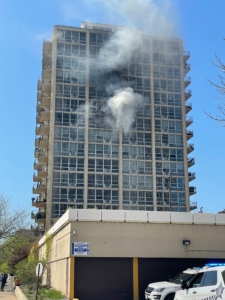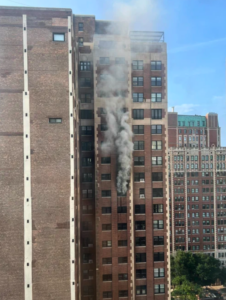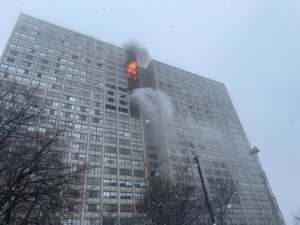By Erik Hoffer, Executive Director, Northern Illinois Fire Sprinkler Advisory Board
Summary of Fires in Unsprinklered Residential High-Rises in Chicago This Year
- Jan. 25: 4850 S. Lake Park Ave. – 1 resident death
- Apr. 5: 1212 N. Lake Shore Dr. – 1 firefighter death, others injured
- Apr. 8: 6430 S. Stony Island Ave. – Residents injured
- Apr. 12: 6151 N. Winthrop Ave.
- May 4: 6730 S. South Shore Dr. – 2 resident deaths in this same building in a 2013 fire
- July 31: 7100 S. South Shore Dr.
- Aug. 18: 421 W. Montrose St. – 1 resident critically injured
- Sep. 10: 3620 S. Rhodes Ave.
- Sep. 23: 3550 S. Rhodes Ave.
- Oct. 4: 6401 S. Yale Ave.
- Oct. 9: 3110 N. Sheridan Rd. – 1 resident critically injured
Less than 10 months. Eleven fires. Residents and firefighters killed and injured. Residents displaced for months on end and lives disrupted. Precious memories destroyed. Millions in property losses.
Like clockwork, the fires keep happening. And in unsprinklered high-rises the destruction of fires is massive. We must not become numb to the persistent tragedy of high-rise fire losses that could have been prevented by retrofitting the buildings with fire sprinklers. This is a problem in Chicagoland and across our state.
The fire danger in older residential high-rises is alarming. There are roughly 600 to 700 unsprinklered high-rises in Chicago alone. These substandard buildings risk the lives of residents as well as responding firefighters.
Anyone living in a high-rise without fire sprinklers is living in extreme danger. Residents of unsprinklered high-rises are much more likely to die or be injured in a fire, and those lucky enough to escape a high-rise fire may face significant property losses. According to the NFPA report, U.S. Experience with Sprinklers (2021), “Sprinklers reduce the impact of fires. Compared to reported fires in properties with no automatic extinguishing systems (AES), when sprinklers were present, the civilian fire death and injury rates per fire were 89 percent and 27 percent lower, respectively. The rate of firefighter injuries per fire was 60 percent lower.”
Fire sprinklers are the single most effective way to protect high-rise occupants, firefighters and property when a fire occurs. All high-rises that lack this critical safeguard should be retrofitted with sprinklers due to the fact that high-rises present life-safety challenges such as smoke movement and control, large numbers of people, and longer egress distances traveled on stairs.
Fire sprinklers can stop a fire in less than one-and-a-half minutes, giving residents more time to escape, protecting residents and firefighters and dramatically reducing property damage. Sprinklers prevent fires from reaching flashover, which can trap and kill occupants in as little as two minutes.
In addition to the savings in lives and property, sprinklers have monetary value. Installed fire sprinklers earn residents reduced fire insurance rates and make a high-rise more attractive to prospective occupants. Plus, installing fire sprinklers in residential high-rise buildings yields insurance savings for building owners when common areas are sprinklered.
“These tragic fires simply didn’t have to happen,” said Erik Hoffer, executive director of NIFSAB. “Any high-rise without fire sprinklers is high risk and needs to retrofitted with them to keep residents and firefighters safe.”
####





